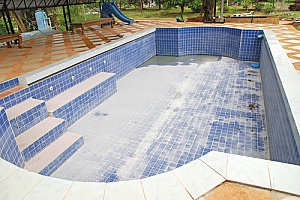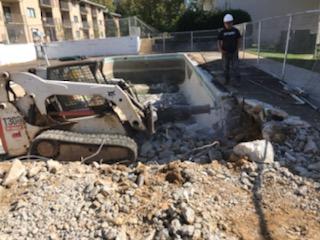After careful consideration, you’ve decided you want to remove your existing swimming pool. You do want the removal process done right and with no headaches. Below, I will provide you with information and answers to the many questions you might have. The information provided will allow you to select the professional you need to complete your swimming pool removal.
Swimming Removal Types
2 Types of Inground Pool Removal
The two types of inground swimming pool removal options are total and partial removal. We will speak to both of this options.
Total inground pool removal, requires heavy equipment. The pool steel reinforcement can be 3/8″ to 1″ thick. Thick steel and concrete demands the use of heavy equipment. Heavy equipment will use hydraulic hammers to breakdown the concrete. Broken concrete allows for the removal of the concrete material from the ground. Dump trucks can now be loaded with the concrete. Concrete with rebar is expensive to haul off and dispose of. You can understand broken concrete with steel can be of little use to others. To reclaim this material into something into a useful sellable material requires expensive equipment and time. This adds to the expense of a total pool removal. This is complete removal of all inground pool items.
Partial pool removal involves heavy equipment, lighter in nature. This process includes the installation of holes at the bottom of the existing pool. The breakdown of the pool edge will ensure a successful project. Dirt Connections breaks down the swimming pool edge 36 inches below the existing grade or pool coping. The depth of 36 inches allows for plenty of safe ground cover grading over the partial pool removal.
Swimming pools offer homeowners the best thrills and fun. If your swimming pool is quite old or damaged, you’ll need to demolish it; and to do this, you’ll require the services of an experienced swimming pool removal company. Homeowners demolish their pools for two primary reasons which are: To completely get rid of the pool for specific purposes, or to demolish the old pool to install a new one.
Above Ground Pool Removals
Above ground pools are among the easiest to remove. The process consists of draining the pool, unbolting and tearing down the walls, and hauling away the debris.
Inground Pool Removals
The process of removing an inground pool is more involved, the cost typically begins at around $5,000 for a partial removal and $19,000 + for a full removal, which entails removing the entirety of the pool structure.
Costs
Fiberglass and vinyl pools are less expensive to remove. Concrete and gunite are heavier materials that need to be broken down with special equipment, making pools with these elements more expensive to remove. The access to the pool removal area will have a direct effect on the project costs.
How Much Does It Cost To Remove A Pool?
Pool removal costs range from $2,700 to $12,000. Larger and complete pool removal can be as high as $19,000 +. As the consumer, please get three estimates. Estimates are usually provided at no cost.
Fill Materials
Clean fill dirt is typically used in the backfill process of your pool removal project. This type of material is provided at reduced costs. This may or may not be necessary based on your final landscape goals (sod, patios, grass seed, etc.).
The Removal Process
Holes at the Bottom of the Pool are Important
These holes allow for the transfer of water through the remaining concrete with a partial pool removal.
Demolition
Concrete is broken with concrete hammers and placed inside the pool cavity. The edges are broken to a depth of 36 inches for our market area. This can provide for the installation of future building footings with other construction projects.
Pool Area Grading
With completion of the inground pool removal, the importation of fill dirt is necessary. The fill dirt will fill the void created by the total or partial pool removal. As the machine places the fill dirt, compaction does occur. With continued fill dirt placement and compaction, the void will be filled.
Ground Cover
Grade work complete, you are now able to install your ground cover. This can be sod, grass seed or a combination of the two. Sod is grass with soil beneath it. The grass is held together by its roots. Sod is grown and harvested from specialty farms. Grass seeds are produced in a variety of types. Some grass types are Fine Fescue, Kentucky Blue Grass, Rye Grass and St. Augustine Grass. Check with your local contractor for the proper grass type for your area. The new area can provide for a host of new landscaping ideas.
Requirements
Contractor License
You want to hire a licensed general contractor. Ask for a copy of the license. General Contractor’s know how to secure building permits and how to comply with all local ordinances. Knowing you hired a licensed professional is going to give you peace of mind.
Contractors Insurance
Contractors insurance is coverage that can protect the general contractor and the customer from devastating financial debts that can result from work-related accidents. It’s important to protect your livelihood. Customers need to be contractors have insurance. The three types of insurance for general contractors are, General Liability, Automobile Liability and Workers Compensation. You can request a copy of the certificate of insurance. This is a common practice.
Project Inspection & Building Permit Closeout
Any time you are providing building, remodeling and or demolishing work to a property, you likely need a building permit. This provides for the legal permission from you city/county to begin work on your project. With legal permission, you can start work on your project. The start of your project, will lead to an end. At the end of your project, you must close out your permits. This usually includes a final inspection from an official with the building permit office. Don’t forget this step. Permits that remain open can cause serious issues. These issues can potentially act as a lien on the site and are a liability to the property seller. Permits left open for months or years after project completion can cause a major headache for people. Always seek an immediate final inspection and close out your permit.
Choosing the Right Pool Removal Option
When deciding on the best method for pool removal, consider your needs and budget. Total removals involve extensive work with heavy equipment to remove all pool components, while partial removals focus on breaking down the pool and filling the space. Costs vary based on pool type, size, and material. For a smooth process, hire a licensed contractor with proper insurance. Ensure that building permits are secured and closed out properly to avoid future complications. The right choice will help you achieve a clean and efficient removal.
Summary

The new space provided can be used for something more significant such as an added lawn, new backyard porch and deck, or a sunken area with a fire pit for entertaining visitors. The swimming pool removal process isn’t an easy job; it’s a job that requires a high level of skills, experience, and expertise. Dirt Connections can provide you the prompt, precise, professional service you deserve. If you have any questions, contact our office.















































